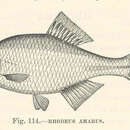Diagnostic Description
provided by Fishbase
Caudal fin with 19 to 20 soft rays. Differs from Rhodeus meridionalis by having sub-inferior mouth (vs. terminal), rostral cap covering all or at least more than half of upper lip (vs. only upper part of upper lip) (Ref. 59043).
Life Cycle
provided by Fishbase
Spawns in clear, slow-running or still water, often with a muddy bottom. The presence of nearby freshwater mussels is of vital importance. Female deposits eggs within the valves of the mussel. Male sheds sperm into the inhalent current of the respiring mussel and thereby, fertilizes the eggs. Fry remain in the mussel until protection is not anymore required.
Morphology
provided by Fishbase
Dorsal spines (total): 3; Dorsal soft rays (total): 8 - 10; Analspines: 3; Analsoft rays: 8 - 10; Vertebrae: 34 - 36
Trophic Strategy
provided by Fishbase
Among plants over sand and muddy bottoms in shallow waters. Remarkable for its habit of deposing its eggs in the cavity of bivalves (Unio). Feeds mainly on plants and to a lesser degree on worms, crustaceans, and insect larvae.
- Recorder
- Drina Sta. Iglesia
Biology
provided by Fishbase
Occurs most abundantly in still or slow-flowing water with dense aquatic vegetation and sand-silt bottom as lowland ponds, canals, slow-flowing rivers, backwaters and oxbows, where mussels are present (Ref. 59043). Found among plants over sand and muddy bottoms in shallow waters. Remarkable for its habit of deposing its eggs in the cavity of bivalves (Unio). Feeds mainly on plants and to a lesser degree on worms, crustaceans, and insect larvae. Formerly used for pregnancy tests: females injected with urine from pregnant women protruded their ovipositors (Ref. 6258). Live span is exceptionally up to 5 years but most individuals do not survive the year of their first reproduction and population sizes fluctuate greatly over the years (Ref. 59043).
- Recorder
- Crispina B. Binohlan
Importance
provided by Fishbase
fisheries: of no interest; aquarium: commercial; bait: occasionally
- Recorder
- Crispina B. Binohlan

